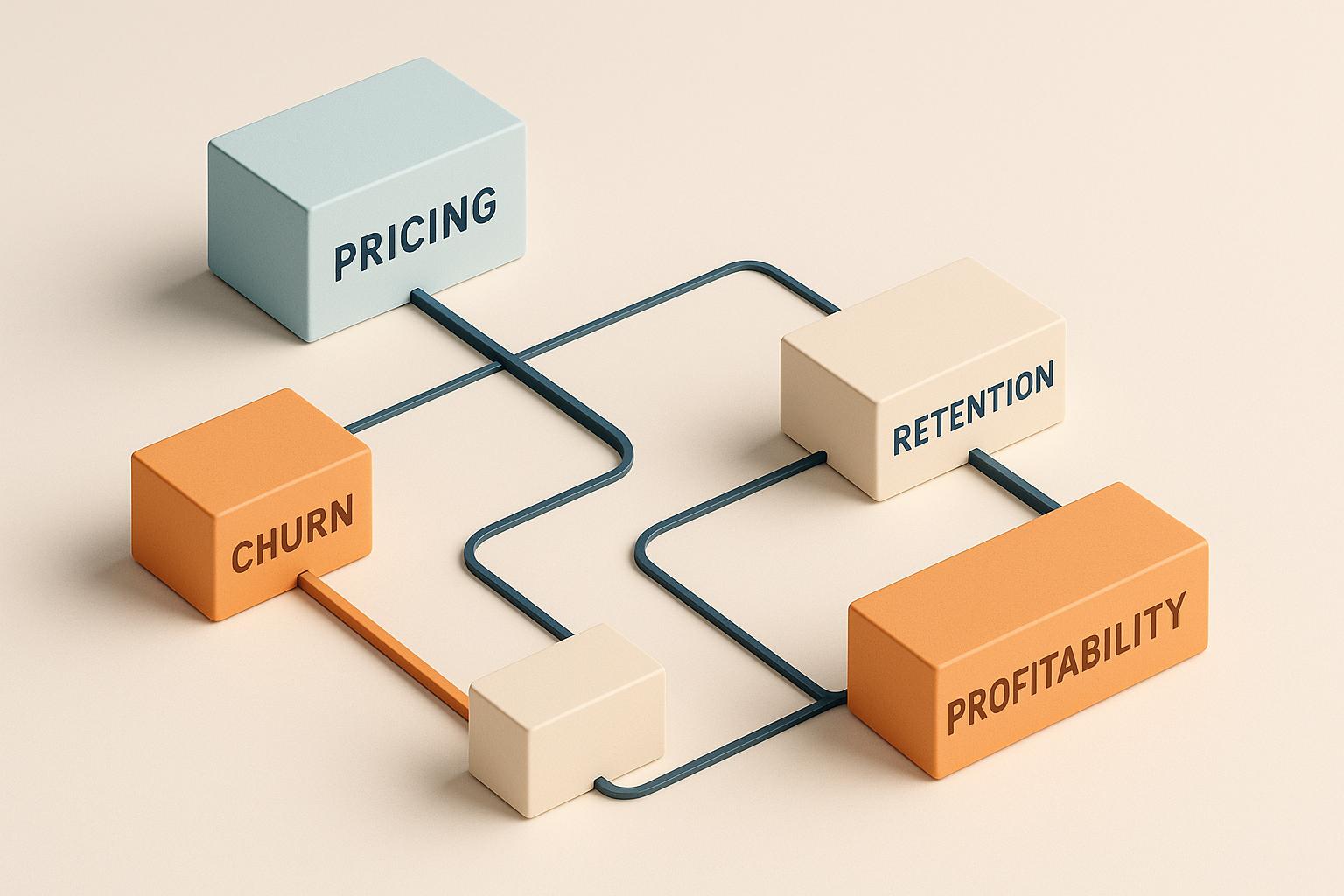How To Analyze Overtime Costs For Better Profit Margins

Overtime costs can quietly drain profits if left unchecked. To manage them effectively:
- Understand Total Costs: Overtime isn't just about extra wages. Include hidden expenses like payroll taxes, higher workers' compensation premiums, and burnout-related costs (turnover, training).
- Track and Analyze Data: Use tools to monitor overtime trends by department, shift, or employee. Identify patterns and root causes, such as understaffing, equipment issues, or inefficient scheduling.
- Plan Proactively: Incorporate overtime data into financial models, set department-specific budgets, and use predictive analytics to forecast staffing needs.
- Leverage Technology: Automated scheduling and real-time tracking systems reduce errors, improve compliance, and provide actionable insights to avoid unnecessary overtime.
- Reduce Reliance on Overtime: Implement strategies like cross-training employees, staggered shifts, and hiring part-time or temporary workers during peak periods.
How to Calculate and Analyze Your Overtime Costs
Understanding and controlling overtime costs means looking beyond just the extra wages. You need to account for both the direct and hidden expenses that can quietly eat into your profits.
1. Calculate Overtime Rates and Hours
Start by determining overtime rates based on federal and state labor laws. For example, the Fair Labor Standards Act (FLSA) requires overtime pay at 1.5× the regular hourly rate for hours worked beyond 40 in a week. Some states have additional rules, like overtime after 8 hours in a single day.
To calculate an employee’s overtime rate, multiply their base wage by the overtime multiplier. For instance, if someone earns $25.00 per hour, their overtime rate at time-and-a-half would be $37.50.
Use digital time-tracking tools to log overtime hours accurately and flag when thresholds are reached. These systems not only simplify tracking but also provide audit-ready records for compliance purposes.
Remember to account for different types of overtime. Regular weekly overtime, holiday pay, and emergency call-ins may have varying rates. Additionally, weekend work might qualify for premium pay, even if the employee hasn’t hit 40 hours for the week, depending on company policies or union agreements.
2. Include Indirect Costs
Overtime costs go beyond just paying higher wages. Payroll taxes, such as Social Security, Medicare, and unemployment taxes, increase as overtime wages rise.
Benefits costs also grow. Workers’ compensation premiums, for instance, often increase because overtime hours can lead to higher injury rates due to fatigue. If your workers’ comp rate is 2.5% of payroll, that percentage applies to the higher overtime wages as well.
You’ll also need to factor in supervisory and administrative costs. Overtime shifts often require management oversight. If a supervisor earning $35.00 per hour stays late to oversee a team of four working overtime, their pay adds to your total overtime costs.
Facility and equipment expenses don’t pause during overtime hours. Utilities, machine wear and tear, and maintenance costs continue, and in some cases, peak utility charges during extended hours may make these costs even higher. For example, if your facility costs $150 per hour to operate, that expense carries over into overtime hours.
Make sure to include all these factors when calculating the true cost of overtime and integrate them into your financial planning.
3. Add Overtime Data to Your Financial Models
Once you’ve calculated the full cost of overtime, incorporate this data into your financial reports. Break out overtime expenses in your profit and loss statements to identify patterns and evaluate cost-saving measures.
Track key performance indicators (KPIs) to monitor overtime as a percentage of total labor costs. For example, manufacturing companies often aim to keep overtime under 5-8% of total labor expenses, while service industries may target 3-5%.
Use 13-week rolling averages to smooth out seasonal fluctuations and uncover long-term trends. A single week of high overtime might be due to a temporary spike in demand, but sustained increases could point to deeper operational issues.
Include overtime costs in your cash flow forecasts. Since overtime pay typically shows up in the next payroll cycle, it’s important to include these expenses in your short-term cash flow projections. High overtime periods can put pressure on cash flow, especially if your business operates with limited working capital.
Set department-specific overtime budgets and compare actual performance against these targets. For example, you might allocate 6% overtime for manufacturing and 4% for shipping and receiving. Regular variance reports help department managers identify and address issues proactively.
To maintain control, consider implementing overtime approval workflows. Requiring managerial approval for overtime that exceeds set thresholds creates checkpoints, ensuring these decisions align with budgets and business priorities.
Find What's Causing High Overtime Costs
Once you've calculated your overtime figures, the next step is identifying what's driving those costs. High overtime often points to deeper operational issues that need attention.
Main Reasons for Excessive Overtime
Several common factors contribute to overtime costs:
- Understaffing: When there aren’t enough employees to handle workloads, extra hours become unavoidable. This could mean your scheduling needs improvement or you simply need more staff.
- Equipment failures: Breakdowns can delay production, forcing tasks to spill into overtime hours.
- Inefficient scheduling: Poorly planned schedules can leave gaps during busy periods or fail to account for absences and training needs.
- Unpredictable customer demand: Sudden rush orders, seasonal spikes, or unexpected contract changes can push employees to work beyond normal hours.
- Operational inefficiencies: Outdated processes or communication breakdowns can slow things down, leading to overtime to meet deadlines.
Use Data to Identify Issues
Data analysis can help you confirm and measure these challenges. Look at historical overtime trends to spot patterns - are there specific days, shifts, or departments where overtime consistently spikes?
Breaking down overtime by department, shift, and even individual employees can reveal concentrated problem areas. For example, if one department consistently logs more overtime, it may signal a staffing issue or process inefficiency.
Compare planned production schedules with actual outcomes to uncover bottlenecks. A root cause analysis can then connect these overtime spikes to specific issues like equipment downtime, unexpected orders, or gaps in staffing.
Visualize Problem Areas with Reports
Visual tools make it easier to interpret overtime data and take action. Automated systems can track real-time overtime and notify managers when thresholds are nearing.
Dashboards are especially useful, allowing you to view trends by week, month, or department. This makes it simple to adjust staffing or schedules proactively. Custom reports can filter overtime by criteria such as emergency versus planned overtime or by project, helping you see exactly where costs are highest.
Regular audits - whether monthly or quarterly - keep you on top of these trends. By continuously monitoring and evaluating staffing plans and schedules, you can make data-driven adjustments to reduce overtime expenses.
Use Technology to Manage Overtime Better
Technology has reshaped how businesses handle overtime, shifting from reactive fixes to proactive workforce management.
Tools for Tracking Overtime and Scheduling
Modern scheduling software takes much of the uncertainty out of workforce planning. These tools use historical data and employee availability to create optimized schedules that help prevent overtime. They also alert managers to potential overtime risks early, giving them time to adjust staffing levels before problems arise.
Real-time tracking systems go a step further, replacing manual timesheets with automated systems that capture exact work hours and notify managers when employees approach overtime thresholds.
Predictive analytics tools bring even more precision to the table. By analyzing seasonal trends, customer demand, and past overtime patterns, these tools help forecast staffing needs. This allows businesses to plan ahead - whether it’s hiring temporary workers or tweaking schedules before busy periods hit. Mobile apps also make life easier for employees, letting them request time off, swap shifts, and check schedules remotely. This reduces last-minute absences that can lead to unplanned overtime.
By laying this digital groundwork, businesses can move toward automation, which takes overtime management to the next level.
How Automation Helps
Automation simplifies overtime management by minimizing errors and ensuring policies are applied consistently. It calculates overtime rates accurately, reducing compliance risks and disputes.
Proactive alert systems are another advantage. They notify managers when employees are nearing overtime, enabling quick adjustments to avoid unnecessary costs.
For businesses working with financial advisory services like Phoenix Strategy Group, automated overtime tracking can be integrated into broader financial planning. Real-time overtime data feeds directly into cash flow forecasts and budget models, offering a clearer picture of labor costs and their impact on profitability. This ensures overtime management aligns seamlessly with overall financial goals.
Manual vs. Automated Overtime Management
Here’s a comparison of manual and automated approaches to managing overtime:
| Aspect | Manual Management | Automated Management |
|---|---|---|
| Time Investment | Requires significant manual effort for scheduling | Streamlines processes with minimal ongoing input |
| Accuracy | Prone to calculation errors and inconsistencies | Delivers precise, automated calculations |
| Response Time | Reactive, addressing issues after they occur | Proactive, with alerts before overtime happens |
| Cost Visibility | Relies on delayed reviews and periodic reports | Provides real-time insights into labor expenses |
| Compliance Tracking | Depends on manual records, often with gaps | Automatically creates reliable audit trails |
| Scalability | Becomes unwieldy as workforce size grows | Adapts easily to business growth and complexity |
Automated systems also generate detailed audit trails for every schedule change and overtime instance. This simplifies compliance reviews and helps address employee concerns by ensuring every minute of overtime is tracked and calculated consistently. By eliminating errors common in manual processes, these systems give managers more time to focus on analyzing trends and implementing strategies that improve profitability in the long run.
sbb-itb-e766981
Ways to Cut Overtime Costs and Increase Profit Margins
Reducing overtime costs doesn’t just save money - it can also streamline operations and improve overall efficiency. By focusing on smarter scheduling, clear metrics, and scenario planning, you can minimize reliance on overtime while protecting your profit margins.
1. Smarter Workforce Scheduling
Tailor your staffing strategy to match demand patterns rather than sticking to rigid schedules. Analyzing historical data can help identify peak periods and quieter times, allowing you to better allocate your workforce.
Cross-training employees is another smart move. When team members are equipped to handle multiple roles, you gain the flexibility to redistribute tasks during busy times without resorting to overtime. It also provides a safety net for unexpected absences.
Consider staggered shifts instead of the traditional 9-to-5 approach. By overlapping shifts, you can ensure adequate coverage during peak hours while keeping individual employees within their standard 40-hour workweeks.
Part-time workers can also be a cost-effective solution. They can fill in during predictable busy periods, helping you avoid the higher expenses that come with overtime pay.
2. Establish and Monitor Overtime KPIs
Clear metrics are essential for keeping overtime in check. Start by calculating key figures like your overtime percentage and the cost per overtime hour, factoring in premium pay, payroll taxes, and lost productivity.
Dive deeper by tracking overtime trends across departments, shifts, or even individual managers. This level of detail can pinpoint inefficiencies and highlight areas that need attention. Weekly trend reviews allow for quick adjustments to schedules before issues escalate.
3. Scenario Modeling for Better Profit Planning
Understanding how overtime reductions impact your bottom line starts with scenario modeling. Begin by calculating your current overtime costs as a percentage of labor expenses. Then, explore scenarios where you significantly reduce overtime hours to see how it affects profit margins.
A break-even analysis can help you decide if hiring an additional full-time employee is more cost-effective than paying overtime. Be sure to factor in recruitment, training, and salary expenses for a full picture.
Seasonal planning is another valuable tool. During predictable busy periods, compare the costs of hiring temporary staff, adjusting current employee hours, or outsourcing specific tasks. This approach helps you prepare without relying heavily on overtime.
For businesses working with financial advisory services like Phoenix Strategy Group, these models can be seamlessly integrated into broader financial strategies. This ensures your overtime reduction efforts align with cash flow, budgeting, and profitability goals.
Finally, calculate the ROI of efficiency upgrades. Whether it’s investing in faster equipment or software to streamline workflows, modeling how these changes reduce overtime - and determining their payback period - can help justify the investment.
Conclusion: Main Points for Better Overtime Cost Management
Effectively managing overtime costs goes beyond simply addressing higher pay rates. It requires a clear understanding of both visible expenses and hidden factors like reduced productivity, increased payroll taxes, and employee burnout. Here’s a breakdown of practical steps to help keep overtime costs in check.
Start by calculating all overtime-related costs - both direct and indirect. This includes premium pay, payroll taxes, and any potential productivity losses. Having a complete financial picture allows you to decide when overtime is truly worth it and when alternative solutions might save more money.
Leverage data to identify problem areas. Automated tools can reveal overtime trends across teams, shifts, and managers, giving you the insights needed to address inefficiencies.
Switch to automated scheduling and time-tracking systems to eliminate the hassle of spreadsheets, reduce manual errors, and gain better visibility into labor costs.
Plan your workforce strategically to minimize overtime. Cross-train employees, stagger shifts, and bring in part-time workers during peak periods. Regularly track key performance indicators (KPIs) and monitor trends to catch small issues before they grow into larger, costlier problems.
For growth-stage companies, incorporating overtime analysis into financial planning is crucial. Partnering with experts like Phoenix Strategy Group can help align labor expenses with cash flow, budgets, and overall profitability.
FAQs
What are the main causes of excessive overtime, and how can I address them?
Excessive overtime often arises from uneven workload distribution, staffing shortages, or inefficient workflows. To address this, begin by reviewing your team's workload and schedules to spot any imbalances or roles that are consistently overburdened. Check if your current staffing levels match peak demand periods, and explore whether bringing in additional team members or temporary help could ease the strain.
Leverage data analytics to uncover inefficiencies like workflow bottlenecks or poor resource allocation. For instance, you might discover that certain tasks or departments regularly require overtime due to outdated procedures or communication breakdowns. Once these issues are clear, focus on solutions such as refining processes, adopting smarter scheduling practices, or integrating automation tools. These changes not only enhance efficiency but also help control labor costs, protecting your bottom line.
What hidden costs of overtime should businesses be aware of?
Excessive overtime isn't just about longer hours - it often comes with hidden costs that can quietly strain a business. For starters, employee fatigue and burnout are common side effects of prolonged overtime. Tired employees are less productive, and burnout can lead to higher turnover rates. This means companies end up spending more on recruiting and training new staff, which isn’t cheap.
Long hours can also lead to more mistakes and workplace accidents. These errors might result in expensive fixes, medical bills, or even legal troubles. And let's not overlook payroll issues - miscalculations in overtime pay can lead to tax compliance problems and hefty penalties.
Recognizing these hidden costs allows businesses to make smarter decisions about labor management, ultimately helping to keep expenses in check and profit margins healthier.
How can businesses use technology and automation to control overtime costs effectively?
Technology and automation are game-changers when it comes to keeping overtime costs in check. With real-time tracking of employee hours, businesses can stay on top of schedules and make smarter decisions to prevent unnecessary overtime before it happens.
AI-powered tools take this a step further by analyzing business demands and optimizing staffing levels. These systems ensure the right number of employees are scheduled at the right times, cutting down on overtime while also helping to trim overall labor costs. Plus, automating payroll processes means overtime calculations are accurate, and compliance with labor laws is a breeze - avoiding costly mistakes or penalties.
Using these tools allows businesses to rely on data-driven insights, operate more efficiently, and safeguard their bottom line.




